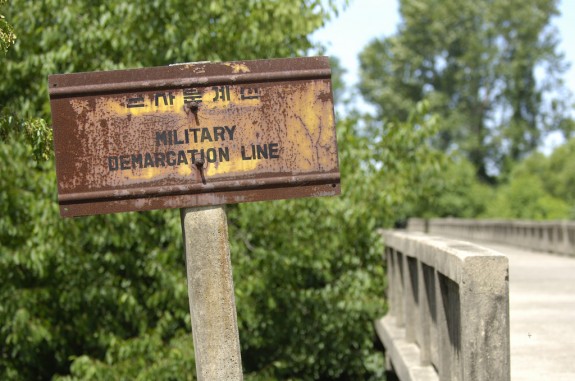North Korea Has Begun a Week-Long Countdown to War
North Korea is threatening to end a 60 year-old ceasefire with South Korea

The Korean demilitarized zone. Photo: US Army / Edward N. Johnson
Month by month, it seems, North Korea has become increasingly aggressive: In December, the country test-launched a long-range rocket. Though carrying a satellite, which the U.S. saw “as a disguised test of ballistic missile technology.” Then came the propaganda video, with disturbing depictions of an American city set aflame—that latest video but the latest in a long-string of aggressive imagery. Then, in mid-February, the country tested its third nuclear explosive, a small device estimated to be equivalent to a 10 kiloton bomb. Now, says Reuters, North Korea is threatening to cancel its 60 year-old ceasefire with South Korea by the beginning of next week unless its demands are met. The Atlantic Wire:
The military command of North Korea says that if South Korea and the United States don’t cancel their joint military exercises by March 11, they can consider that whole 60-year-old armistice agreement totally over. The newest threat comes as China and the U.S. are reportedly drawing up new sanctions that they have negotiated together and will submit the U.N. Security Council to punish the DPRK for its nuclear weapons test last month.
On the Korean peninsula, the North and South have never, technically, stopped being at war. In 1953, an armistice called off the fighting, but a formal agreement of peace was never worked out.
In 1953, with war waging and the U.S. supporting the South, newly elected President Eisenhower, says History.com, “adhered to his promise to ‘go to Korea.’ His trip convinced him that something new was needed to break the diplomatic logjam at the peace talks that had begun in July 1951.”
Eisenhower began to publicly hint that the United States might make use of its nuclear arsenal to break the military stalemate in Korea.
… Whether or not Eisenhower’s threats of nuclear attacks helped, by July 1953 all sides involved in the conflict were ready to sign an agreement ending the bloodshed. The armistice, signed on July 27, established a committee of representatives from neutral countries to decide the fate of the thousands of prisoners of war on both sides.
…A new border between North and South Korea was drawn, which gave South Korea some additional territory and demilitarized the zone between the two nations.
Since the war never actually ended, says The Atlantic Wire, the United States’ 8th army never left, either.
Though tensions are flaring, The Atlantic Wire suggests some calm: “his is not the first time the North has threatened to destroy one or both of its rivals. It’s hard to imagine that the shooting will start again soon, but there’s no doubt that the rhetoric has never been harsher.”
More from Smithsonian.com:
North Korea’s New Video Is Only Its Latest Propaganda About Attacking the U.S.
How Much Damage Could North Korea’s New Nuke Do?
/https://tf-cmsv2-smithsonianmag-media.s3.amazonaws.com/accounts/headshot/smartnews-colin-schultz-240.jpg)
/https://tf-cmsv2-smithsonianmag-media.s3.amazonaws.com/accounts/headshot/smartnews-colin-schultz-240.jpg)